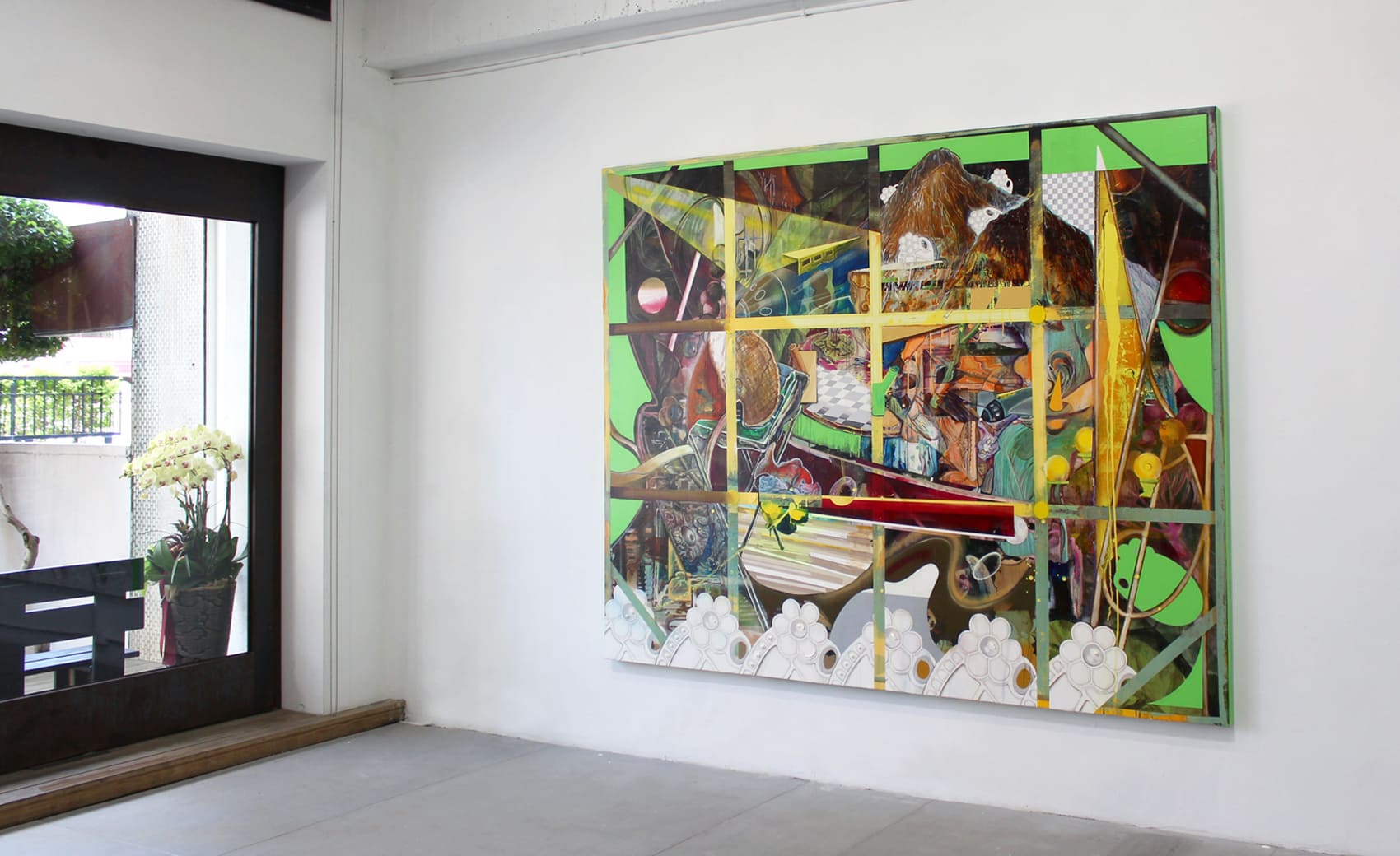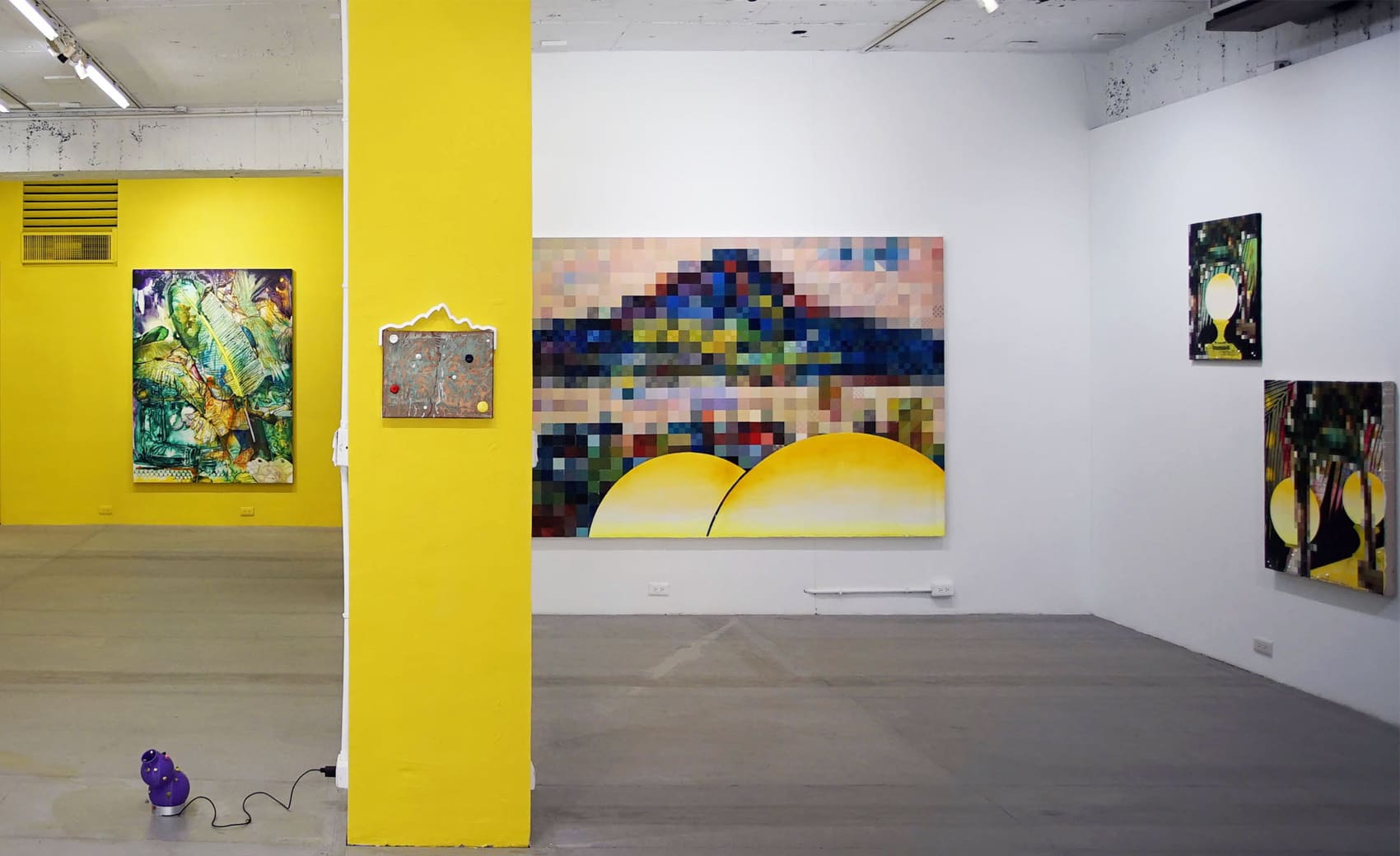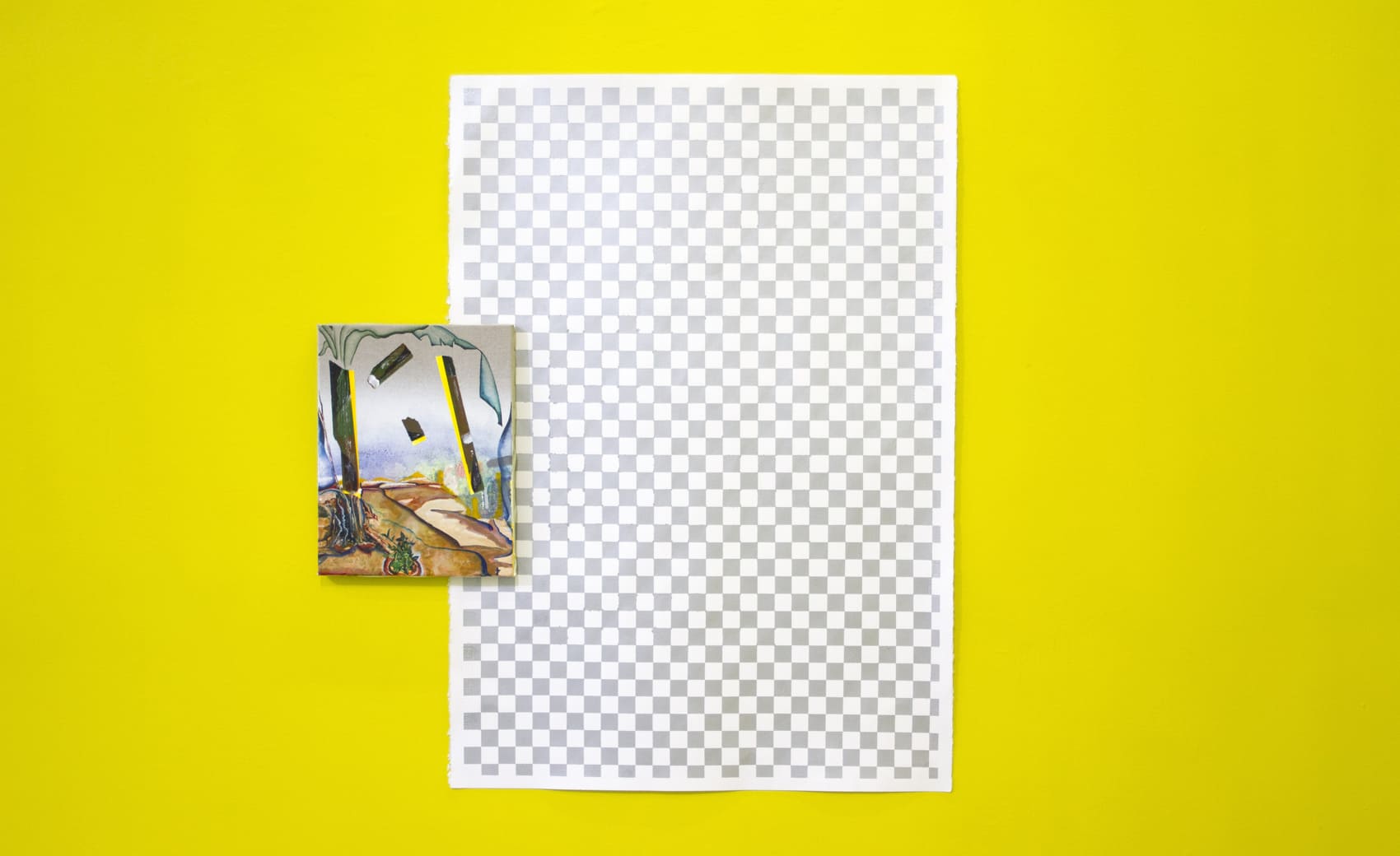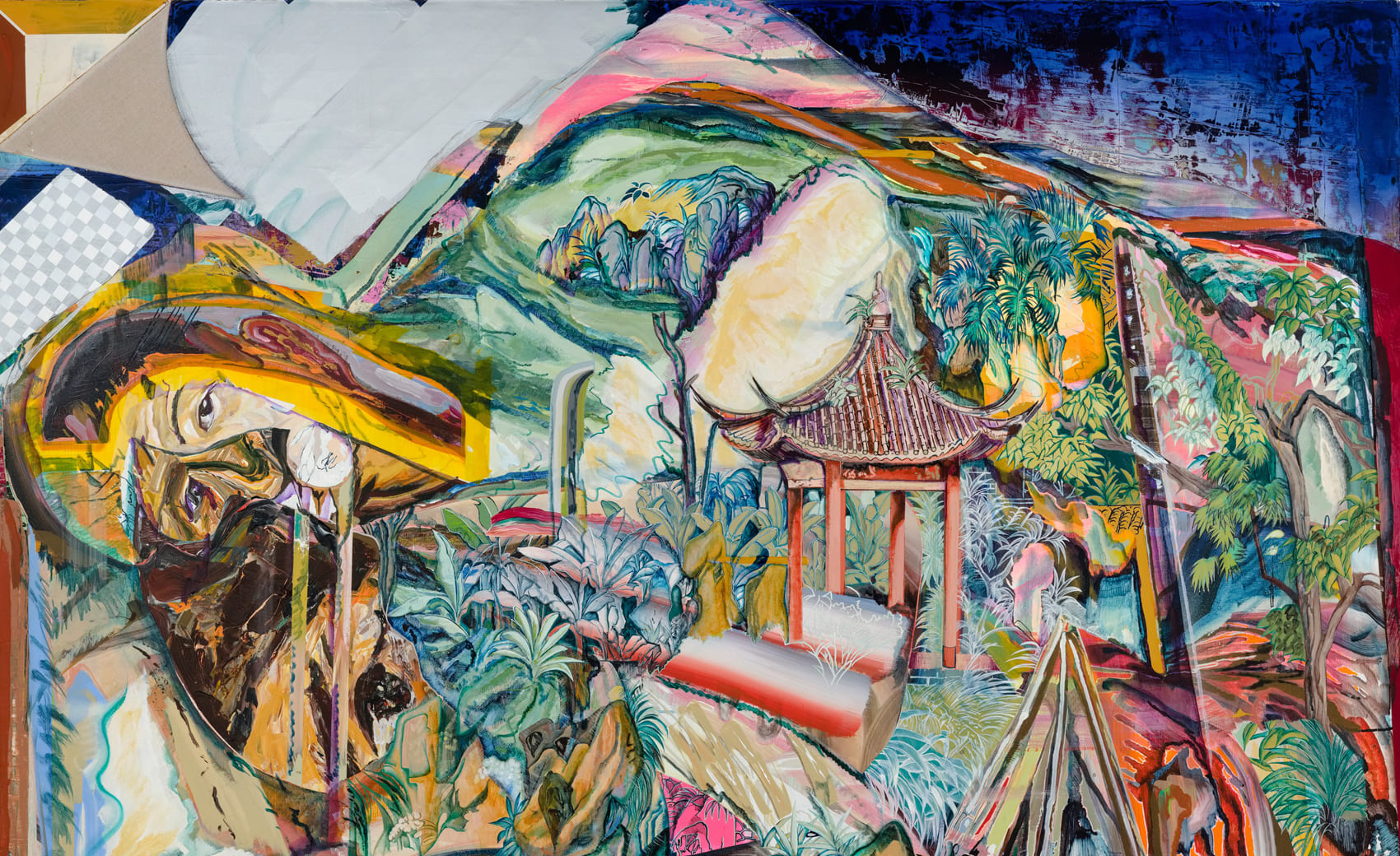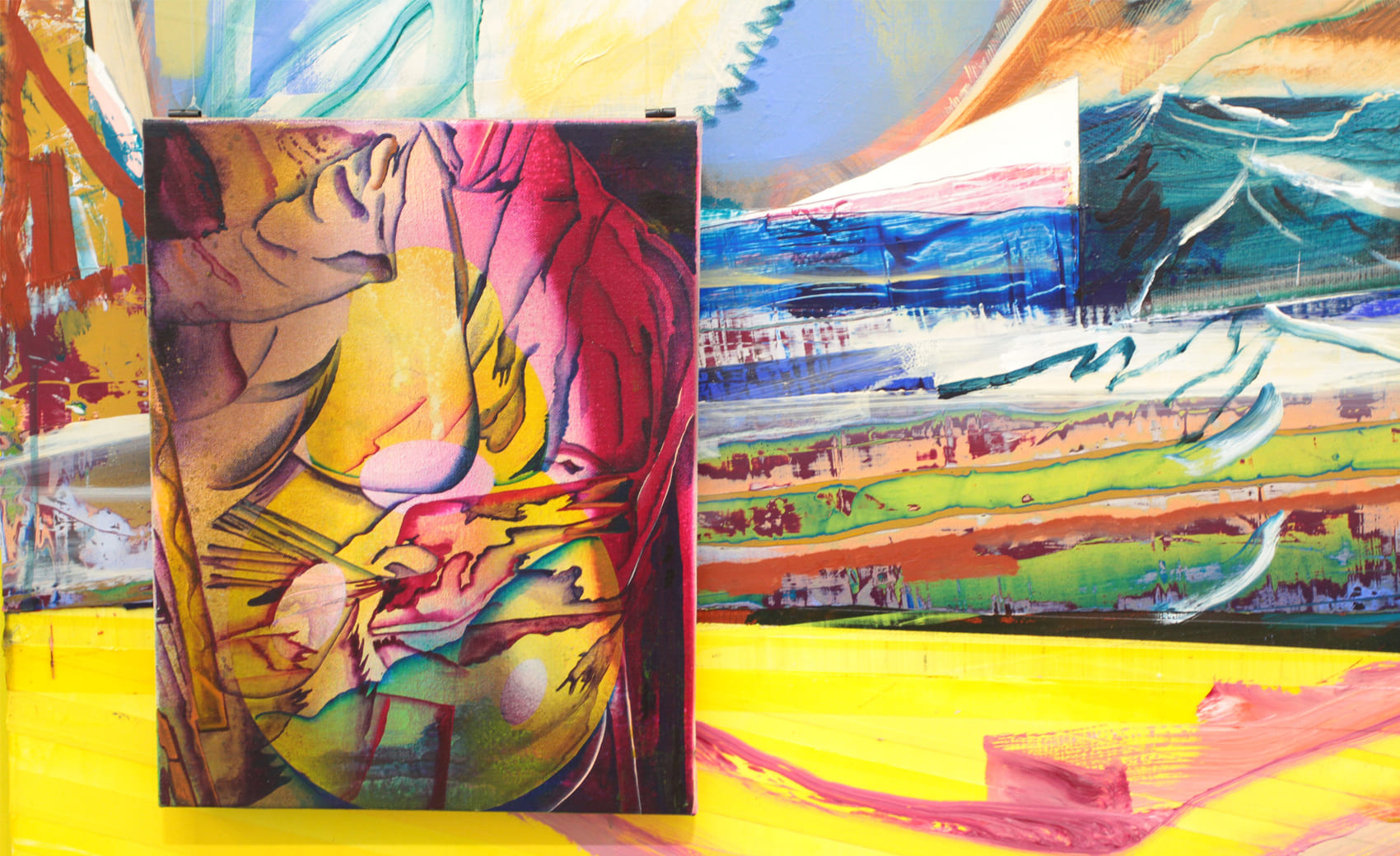延續「前山」、「忘山」,再到此次的「我欠你的畫」,藝術家透過三階段個展探尋臺灣美術史裡的繪畫起源與脈絡,藉由此番凝望與重新詮釋前輩畫作,為自身作為畫家所追尋之問題,諸如繪畫題材、對象物與畫者的關係、繪畫對於本身的意義等,找到可以參照與對視的脈絡。展名中「我欠你的」,源自於父母輩之口的認份宿命論,以及臺語金曲《愛拼才會贏》隱含的時代縮影與小人物打拼精神,代表生命中無法迴避之提問,意味藝術家透過此次新作將拖欠的內在自省償還,而對於企圖在美術史找到相容位置的自我或諸多創作者,更是一種命定的付出。
From Geo-philosophical Mining and Unforgotten to I.O.U a Painting, the artist revisits the origin and development of Taiwanese art history in three stages, which collectively form a journey to gaze into and re-interpret the paintings and tradition by his predecessors. This quest allows the artist to put forth his questions as a painter, such as painting’s subject matter, the relationship between the subject and the painter, as well as the meaning of painting to the artist himself, enabling him to form a context for comparison and contrast. The words, “I owe you,” in the exhibition title originate from how the artist’s parents and their generation have accepted life as is and the zeitgeist and unyieldingly diligent work ethic of ordinary people conveyed by the Taiwanese hit song, “Dedicate Yourself and You Will Win.” For the artist, it is something he cannot avoid in life, and he hopes to reflect and repay what he has owed to the previous generations through the new works featured in this exhibition. For artists, like Hsieh and many others, who attempt to find their position in art history, this endeavor seems an unavoidable devotion.
謝牧岐
生活於臺北。創作形式以繪畫結合各種媒材,在跨足行為表演、攝影與錄像的實驗中,透過自身扮演的不同角色詮釋繪畫的創作途徑、生產模式及其文化傳統,並以幽默戲謔手法引領觀眾思考藝術家身份及自我與繪畫的關係。曾於2016與2017年分別舉辦「前山」與「忘山」個展,重要聯展包括2018年馬尼拉瓦爾加斯美術館「跳島計畫—帝國逆行 : 登陸者」、「一座島嶼的可能性–2016臺灣美術雙年展」等。
Hsieh Mu-Chi is based in Taipei. He combines painting and various media to create his work, conducting experiments of performance, photography and video while personally adopting different roles to interpret the creative approach to painting, its production mode and the cultural tradition of painting. With humorous, playful approaches, he guides the audience to think about the identity of an artist as well as their relationship with painting. His solo exhibitions, Geo-philosophical Mining and Unforgotten, were presented in 2016 and 2017 respectively; and he has been featured in various important group exhibitions, including Lander: Island Hopping—Reversing Imperialism at Jorge B. Vargas Museum and Filipiniana Research Center, Quezon City, Philippines in 2018, The Possibility of an Island—The 2016 Taiwan Biennial and more.
就在藝術空間
林珮鈺
謝牧岐
湯柔
謝牧岐、吳宜曄
林明諺
就在藝術空間
就在藝術
胡永芬 老師
就在藝術空間
關鍵字
- 臺灣當代繪畫
- 臺灣前輩畫家
- 臺灣美術史
- 牧岐與繪畫
- 觀音山
- 自畫像
藝術家談作品
「台灣的美術史不單只是美術,它跟現代史或台灣殖民史,其實是緊密相扣的」。謝牧岐以〈歸途上的風景〉結合林玉山的同名畫作和曾為避禍而改作的〈獻馬圖〉,多方省思以繪畫回應環境、反映時代的動能,體現了謝牧岐認為繪畫可以照見自己,也可映現所處環境的雙面鏡特質。
採訪及文字整理/吳家瑀
如果說,繪畫是為了回歸本身照見生命本質,也為了嵌結於脈絡,映現澆灌於我的土地;怎樣的取徑,能通往雙向的追尋?又是怎樣的呈現,能夠兼容此番深刻?2019年謝牧岐個展,透過與前輩畫家對話,翻攪從裡到外的匱缺,清償多年來欠予自己和繪畫的課題。
回應台灣身份,向前輩畫家請益
每個人生命中總有無法選擇必須面對的課題。展名「我欠你的」,是謝牧岐以一種命定如此的自覺,自問「身為一個台灣藝術家,什麼是你無法拋開、必須去處理的?」這些待處理面對的繪畫功課,謝牧岐認為首當其衝的是「台灣」這個身份。於是他回望過去,向同為台灣藝術家的前輩畫家請益。
「在那個時代,有人說『沒畫過觀音山和淡水河,就不配稱為台灣畫家』。我覺得這句話真的是太有趣了。」前輩畫家以風景入題,雖說部分在回應官展機制,然而對謝牧岐而言,也是一種自然而然:「觀音山、椰子樹或是香蕉樹,都是我們日常生活可見的那個部分。」謝牧岐說,「這些東西在我的作品裡面一直出現,應該說那些東西一直存在。我在這個時空創作,它作為一個時間軸,好像在這裏面的內容,可以透過台灣美術史,建立起一個可以彼此對照或相互參照的關係。」
「在當初威權時代下面,大部分作品都是避禍,不想發生危險,藝術家有時得把自己作品隱藏或是塗改」,前輩畫家面對跨越至今的風景,也面對著時代當下的課題,「台灣的美術史不單只是美術,它跟現代史或台灣殖民史,其實是緊密相扣的」。謝牧岐以〈歸途上的風景〉結合林玉山的同名畫作和曾為避禍而改作的〈獻馬圖〉,多方省思以繪畫回應環境、反映時代的動能,體現了謝牧岐認為繪畫可以照見自己,也可映現所處環境的雙面鏡特質。
曾經瓶頸,曾經學舌
觀眾行經展場中葫蘆型插香器時,會聽見傳出的人聲,說著謝牧岐這些年來尋找資料、與前輩藝術家對話的關鍵字。「平面畫作搭配人聲,有點像是我在面對自己繪畫的幽靈,那個幽靈是我長久累積下來,繪畫的包袱或成見。」學生時代繪畫可以單憑熱情衝勁,然而當它成為專職甚而一生志業,卻越發沉重。「對繪畫探究,應該是從2006年首次個展《一個交錯而過的事件—沒有起始的地方》開始。」謝牧岐說。「那次開始做觀念性的操作,不再獨自一人面對空白畫布。」從那之後,他曾繞行繪畫周邊,透過計畫形式與共同合作來探討藝術產業化議題。雖然創作面向因此日益豐富,裡頭卻潛藏自身對繪畫的遲疑和焦慮:「那時候批判詆毀的對象,就是『執筆畫家』的這個身份,就是畫家其實不太需要技巧,可以透過代工或各種方式去變成藝術家。」實情是拿筆作畫遭遇瓶頸,於是拋棄眼前,另尋途徑,「可是往那個方向發展之後,並沒有真正解決我在畫布上遇到的問題。」
2012年的「山道寫生」計畫,可說是開展「我欠你的畫」的濫觴,「那時候就一直以山脈為主題,寫陽明山、五指山,也想過跑前輩畫家常畫的觀音山。」謝牧岐以觀音山和淡水河為主要畫題,時而前往實地對照畫作與今日異同,有時也臨摹前輩筆觸技巧或擬仿風格特色,陸續舉辦了「前山」與「忘山」個展。「有點像是以風景畫出發寫生,漸漸寫到前輩畫家的畫作裡去。」對於現在作畫的意義,謝牧岐說:「現在我沒辦法說,做這些事能在台灣美術史上留下甚麼或有何評價,但我可以反過來,將那段時空脈絡納進我的作品。」
與前輩面對相同風景,謝牧岐自期能畫出各自精彩,就算引用畫作,也以自己的筆觸和風格為主體,盡力取其內涵再行創造。面對時代更迭,亦希冀有所省思,反映繪畫經驗的世代問題,比如畫作中將形象描繪成格狀馬賽克,模擬圖像解析度不足,便是表達現今透過網路接近真實的影像化閱讀經驗。
向過往存取經驗,逐漸成為實踐的指引、取材的資源。於今所思,就是如何透過此些「時間的碎片」,「創造自己風格,重新組合當下」。謝牧岐說,前兩次個展狀態較像是一種學舌。而直到現在此刻,他好像慢慢地,開始會自己說話了。
評審談作品
此次個展不但是藝術家對於繪畫作為藝術的類型,長久以來的實驗和探討之結論,也同時是面對現代性下,繪畫性(painterliness)所面臨的質疑和挑戰。
此次個展不但是藝術家對於繪畫作為藝術的類型,長久以來的實驗和探討之結論,也同時是面對現代性下,繪畫性(painterliness)所面臨的質疑和挑戰。謝牧岐的作品影射了繪畫技法和擬真能力的有用或無用,同時也引用了台灣藝術史裡幾個關鍵性的藝術家和作品,包括林玉山、李石樵、蔡雲巖等藝術家為迴避政權侵害而塗改的作品,做為個人對台灣藝術史深沉的內化和反思方式。個展也同時以3D列印插香器的方式,和藝術史的現成物及(不)可複製性論述做對話,有和西方強勢論述頡頏的意味。 (主筆/吳介祥)
This solo exhibition not only concludes the artist’s continuous experimentation and exploration of painting as an artistic genre, it also confronts the doubts and challenges concerning painterliness in modernity. Hsieh Mu-Chi’s work signals the ambivalent usefulness of painting skills and mimetic power while alluding to some of the key artists and their works in Taiwanese art history, including Lin Yu-Shan, Lee Shih-Chao and Tsai Yun-Yen, who used to modify their works to avoid political oppression. The exhibition therefore serves as the artist’s profound internalization of and reflection on Taiwanese art history. In the exhibition, the artist also uses 3D-printed incense holders to carry out a dialogue with the concept of readymades and the theory of (ir)reproducibility in art history, conveying a sense of resistance against the powerful theoretical discourses from the West. (Commentator: WU Chieh-Hsiang)


